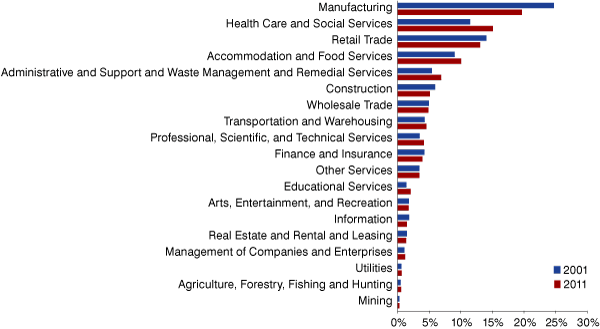Importance of the Statewide Industry Mix
Wage growth in Indiana is a principle concern for policymakers. While many can debate the impact of cost-of-living differences across states limiting the impact of comparative state analysis, most would agree that more work can be done to increase the rate of wage growth. The housing crisis that started in late 2007 and the subsequent recession certainly contributed to slow wage growth.
In understanding wage growth, two elements should be examined. The first is the wage growth of existing jobs. Another, perhaps more subtle, is the changing industry mix that results from job churn. This article focuses on the latter element.
Occupations enter and exit the market. During the housing crisis, many construction jobs were lost. While the state has in the intervening years added a large number of positions back, they were not construction jobs. The industry mix for Indiana employment has changed. It is important to understand this change and its impact on statewide wages.
Quarterly Census of Employment and Wages (QCEW) data were taken from the Hoosiers by the Numbers website (www.hoosierdata.in.gov). These annualized data from 2001 to 2011 detail employment and total wages by large industry sectors (two-digit NAICS). Average wages were calculated by industry and as a total. View details in the companion spreadsheet.
Using the QCEW data, calculated private sector worker salaries averaged $31,759 in 2001 and $40,272 in 2011. The increase in wages of $8,514 represents a growth of 26.8 percent over the period. While this is positive news, it should be noted that on an annualized basis, wage growth has had a difficult time maintaining pace with inflation (30.5 percent over the same period). While the gains are important, the influence of inflation indicates that work remains. Even if these numbers could be muted by cost-of-living adjustments, all would prefer faster real wage growth. It is, therefore, important that the role of industry mix be understood for its importance in tackling the issue.
The employment industry mix was derived for both 2001 and 2011 by calculating the percentage of employment totals by industry. Comparing the employment industry mix over this period highlights some interesting changes and shifts in employment patterns (see Figure 1).
Figure 1: Indiana Private Sector Employment Industry Mix

Source: Quarterly Census of Employment and Wages
From casual observation, the changing industry mix seems rather mild, with the exception of the decrease in manufacturing and increase in health care. However, even seemingly mild changes in the state’s industry mix can have significant impacts on worker salaries.
In an effort to determine the importance of industry mix, a calculation was done to assess the potential impact on wages. First, the 2001 industry mix percentages were applied to the total private sector employment in 2011. Differences were then calculated representing the difference in employment from the current and the hypothetical created using the 2001 industry mix percentages.
Second, sector wages were individually calculated using 2011 wages and the 2011 hypothetical employment. Using 2011 total employment and industry wages with 2001 industry mix patterns, annual salaries in this hypothetical scenario should have been $41,384 (see Table 1).
Table 1: Industry Mix Analysis
| Year | Salaries |
|---|---|
| 2001 Annual Wage | $31,759 |
| 2011 Annual Wage | $40,272 |
| 2011 Annual Wage If There Were No Change in Industry Mix from 2001 | $41,384 |
Source: Quarterly Census of Employment and Wages
This would have represented a 30.3 percent increase over the period vs. 30.5 percent for inflation. Rather than falling behind inflation, Indiana would have nearly maintained pace with it if the industry mix had remained unchanged.
Essentially, the changing industry mix from 2001 to 2011 cost the average Hoosier worker about $1,112 in additional wage growth. On a statewide basis, this represents a $2.62 billion loss in additional wage growth.
This analysis utilizes a great number of unrealistic assumptions and the results should be treated with caution. The back of envelope calculation and analysis are only designed to convey the importance of industry mix in determining the wages of Hoosiers.
